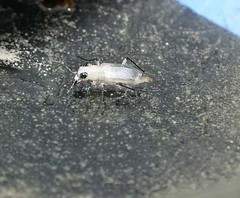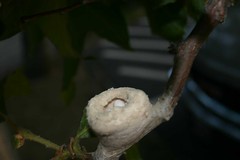
Ginkgo biloba, or the Maidenhair tree, once was thought to have died out with the dinosaurs, was discovered alive in a small grove in Central China. It comes in males and females and it's the females which produce the stinky fruit which contains flavonoid glycosides and terpenoids that are vasodilators and thought to help in brain function and in particular, memory.
I was recently told how to distinguish the difference between the sexes of the trees by a phrase, "... the girls wear skirts and the boys wear pantaloons." And it is true that some trees have split leaves that make each leaf look like two, and others have small slits or no slits at all. I have a girl tree and she produces the stinkiest fruit. It smells just like a mix of dog poo and vomit. What a combination! I can't imagine how people would think to try to eat them.... discovering their medicinal properties.... Only, perhaps if you think that if it smells bad it must be good for you!

Lagerstroemia, or Crepe myrtle have been planted all over Pasadena, California. It likes warm summers and nice rain and cool winters. When I lived in Ohio, I saw people try to grow these trees. They are quite beautiful. Their flowers, which cover the entire tree like a puff ball, come in purple, pink, red, and white. And in winter, their leaves turn red before falling. However, even when the people in Ohio wrapped their Crepe myrtle in blankets (which they did) the cold winds would either stunt the growth or kill the tree.


The leaves of both trees have mostly fallen off. I use them in the flower beds for color. I rake them up and sprinkle them over the bare dirt. I suppose that my neighbors think I am crazy, but the leaves provide the rich colors of red, yellow and orange in a normally brown ground, and eventually the leaves become mulch for the plants in the dry summers.
But, as I was looking at the fall of the leaves on the bricks, I could not help see how statistics work. My Crepe myrtle is older and has many more leaves then my Ginko and so the leaf drop is much more dense from the Crepe myrtle. One could see that if you were considering what the chances were for a particular incident, say of getting in an accident in your car, the more times you drive the chances increase. The fewer the times the chances go down. Or, how about.... the chances of winning the Loto or at Craps or at cards do go up if you play long enough.... but how much money do you loose in the end? Or... what are the chances of having cancer, or some other disease... the more exposure the higher the probability.




















































